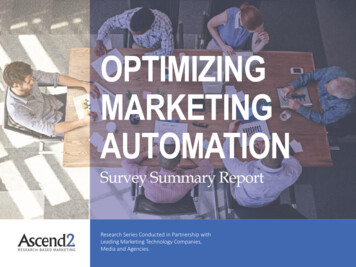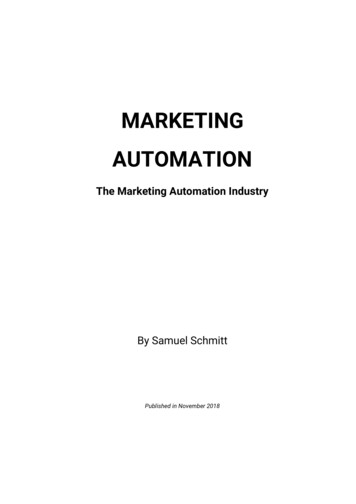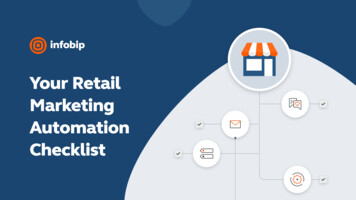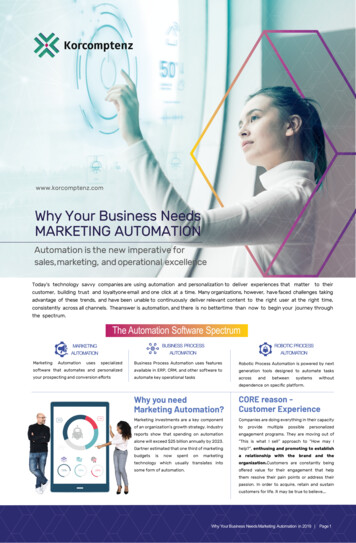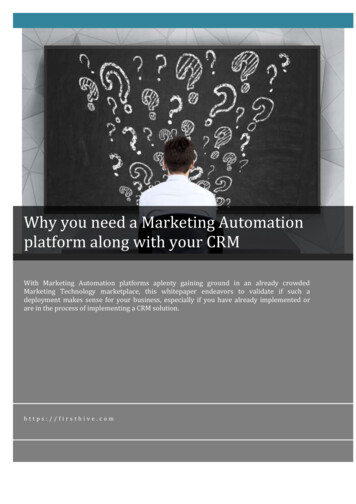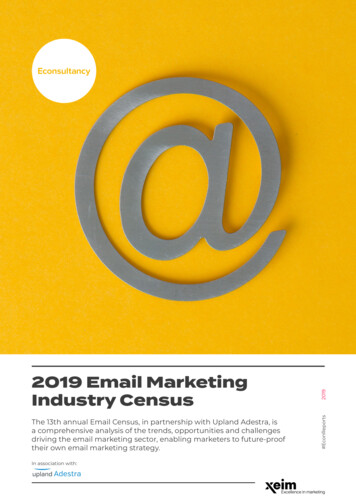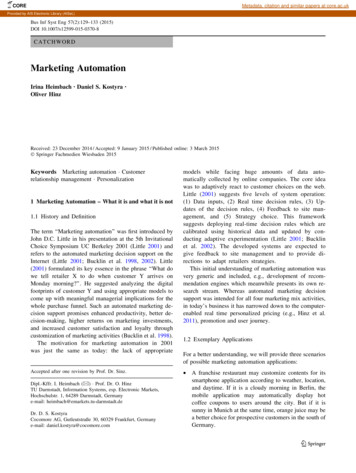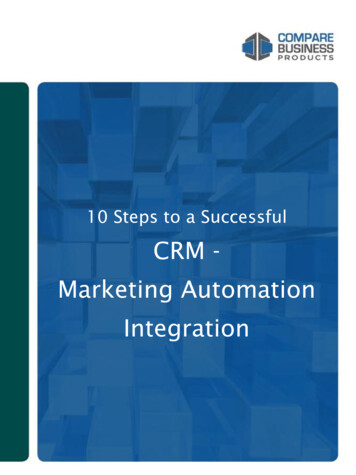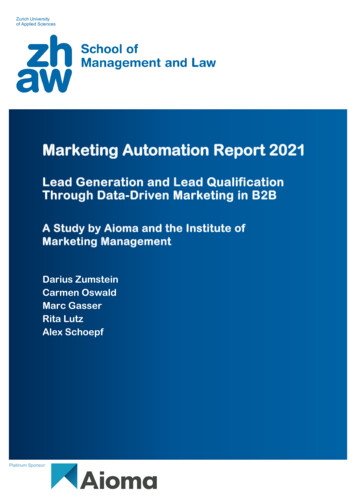
Transcription
Zurich Universityof Applied SciencesMarketing Automation Report 2021Lead Generation and Lead QualificationThrough Data-Driven Marketing in B2BA Study by Aioma and the Institute ofMarketing ManagementDarius ZumsteinCarmen OswaldMarc GasserRita LutzAlex SchoepfPlatinum Sponsor:
IMPRINTPublisherZHAW School of Management and LawTheaterstrasse 17P.O. Box8400 WinterthurSwitzerlandInstitute for Marketing Managementwww.zhaw.ch/immProject Management ContactDr. Darius Zumsteindarius.zumstein@zhaw.chClient ContactAioma AGwww.aioma.comMarc Gassermarc.gasser@aioma.comFebruary 2021DOI: 10.21256/zhaw-2402Copyright 2021,ZHAW School of Management and LawAll rights for reprint and reproduction of this work are at theInstitute of Marketing Management IMMZHAW School of Management and Law.The passing on to third parties remains excluded.
3 Marketing Automation Report 2021Management Summary2020 was a turbulent year that brought many far-reaching changes. During the Corona crisis, digital value chainsbecame the “saving anchor” for many companies. Exhibition fairs, conventional advertising, and physical meetingslost importance. Sales through online shops increased rapidly, digital platforms and customer portals gained prominence, and sales and marketing became more digitalized. In addition, many organizations were forced to pursuetheir digitization programs comprehensively and uncompromisingly. In 2020, it became apparent that people andcompanies can adapt quickly if necessary. In general, technologies can change rapidly, but organizations moreslowly. In the future, marketing automation will be critical to interactive success between customers and companieswith their numerous digital touchpoints such as websites, online shops, social media, search engines, and newsletters.This study examines what Swiss companies think about marketing automation, whether they use it, and how theyuse it. It is aimed at marketing and sales specialists involved in the process of automation and digitization. Aroundtwo-thirds of the 402 specialists who took part in the survey during the fall of 2020 work in business-to-business(B2B), and the others are split 15 percent each into business-to-consumer (B2C) and hybrid types (B2B2C).Almost all the companies use email, social media marketing, and search engine marketing, while the majority usescustomer relationship management (CRM), digital analytics, and a content management system (CMS). Forty percent of respondents use marketing automation, of which a quarter use software extensively, and one-third use it toa limited extent. This study reveals that “successful” companies – those who are better at achieving their onlinestrategy goals – frequently use these marketing technologies. Successful companies are three times more likely touse a marketing automation tool than those unsuccessful at achieving their goals, and companies with large budgets twice as often as those with small budgets.Marketing automation encompasses several benefits: For half of the companies surveyed, it saves time on repetitivetasks and personalized communication. For 45 percent, it increases efficiency and the return on investment (ROI)in marketing. For 39 percent, it leads to higher lead quality, and for over one-third, it results in more leads or conversions. Marketing automation improves responsiveness and collaboration between marketing and sales at one inthree companies. For half of all the companies, the most valuable marketing automation software function is integration into existing systems – CMS, CRM, and ERP (enterprise resource planning). Marketing automation is alsoused to qualify, score, and nurture leads. Rules (workflows) ensure the distribution of content via emails and socialmedia channels.The collection of high-quality customer data and the limitations of the current systems present a challenge. Lack ofskills and know-how are also major issues, as are inefficient processes. One of the factors preventing companiesfrom introducing marketing automation is usually a lack of internal expertise. For one in four companies, insufficientdata quality, lack of prioritization, and budgeting issues are also significant obstacles – especially among smallercompanies. To determine whether marketing automation delivers the desired benefits and successes, it is essentialto measure key performance indicators (KPIs). For half of the companies surveyed, this is the measurement ofconversion rates along the customer journey, followed by the number of sales-qualified leads (SQL) and the numberof leads or contacts generated. Marketing automation will become part of the digital business strategy for almostevery second company in the future. Over one-third confirm that marketing automation will have a more prominentrole and become part of future digital marketing. Ten percent believe that marketing automation will replace personalcommunication – at least to some degree.
4Table of Contents4Foreword by Aioma512Background5Marketing Automation Is Not Just About Business Efficiency5Marketing automation must address customer needs5Challenges without Marketing Automation5The key to successful marketing automation6Introduction71.1 Study description71.2 Sample71.3 Human and financial resources81.4 Goal achievement8Digital Marketing92.1 Digital fitness of companies92.2 Use of marketing technologies92.3 Online marketing goals122.4 Challenges with online marketing goals15Marketing Automation173.1 Definition of Marketing Automation173.2 Advantages of Marketing Automation173.3 introduction Barriers of marketing automation193.4 Use of marketing automation software203.5 Marketing Automation Software Features213.6 Key Performance Indicators243.7 The Future role of marketing automation25Conclusion264.1 Summary264.2 Marketing Automation – Recommendations and Checklist275References306List of Figures and Tables327Authors338Research Partners359Further Education Programs3634
Data-Driven Marketing in B2B5BACKGROUNDThis study is intended to increase knowledge among B2B organizations about the possibilities of marketing automation. It also serves to analyze the latest developments in online marketing for B2B companies. These insightswill be incorporated into Aioma’s software product to drive automation further so that companies can focus on theessential task of closing deals. This is B2B marketing on autopilot.As a thought leader in marketing automation, Aioma helps B2B companies grow through predictable revenue. Inaddition, Aioma empowers B2B organizations to sell more through better marketing. Clients generate qualified leadson an ongoing basis through automated and personalized content and email marketing.MARKETING AUTOMATION IS NOT JUST ABOUT BUSINESS EFFICIENCYThe automation of recurring processes is one of the core marketing automation tasks, as this study empiricallyconfirms. For example, email campaigns and the collection of lead addresses can be standardized with marketingautomation. However, the advantage of marketing automation is not only the short-term increase in performancethrough isolated, automated processes. With marketing automation, it is possible to acquire customers early inthe customer journey (lead generation), collect information about their interests and needs, and actively guidethem through the customer journey (lead nurturing). In this sense, marketing automation also enables and promotesthe development of long-term, qualitative customer relationships.MARKETING AUTOMATION MUST ADDRESS CUSTOMER NEEDSMarketing automation is successful when customers are offered an individualized buying experience to suittheir needs. To do this, a company must know its customers’ needs in the various phases of the customer journey.Next, relevant content must be created and distributed that precisely serves these needs and offers the customerrelevant information at the right time and through the appropriate channel. Every customer has an individual customer journey and expects tailored information; it is therefore no longer sufficient to bombard each customer withthe same advertising message. The content should not be prepared in a promotional style but focus on a clearlydefined customer need. The more precisely you know the phase your customers are in and the challenges theyface, the better you can address them in a tailored, individual way.CHALLENGES WITHOUT MARKETING AUTOMATIONDepending on the phase of the customer journey, marketing specialists face different barriers. Marketing automation can help them overcome these hurdles and make their marketing activities and processes more efficient. Forexample, marketing automation can help close gaps in the team and data quality, supplementing existingknowledge and data. The situation is similar in later phases of the customer journey. Here, too, marketing automation helps digitize, simplify, and accelerate processes and obtain clear metrics.
6 Marketing Automation Report 20211.Strategic Know-How is the FoundationBefore starting with marketing automation, it is important to define a strategy. Part of this strategy is an overviewof the customer journey – or different customer journey variants – for various types of client. This way, initial assumptions are made about the buyer base, which can then be tested and optimized through marketing automation.Typical customer questions in the buying process, problems, and use cases from the customer’s perspective provide valuable input for creating the strategy. Furthermore, the objectives in digital marketing should be formulatedclearly. An analysis of the current situation is nessecary, to expsose the fundamental problems lie is necessary inany event. Are the greatest levers to be found in lead generation, lead conversion, lead qualification, or even inmeasurability?2.The Quality of the Data is VitalTo inform customers in a targeted manner, data about their interests and needs are required. If this data is notavailable or not of sufficient quality, marketing automation often fails. Accordingly, data from various sources suchas digital analytics, CRM (customer relationship management), CDP (customer data platforms), DWH (data warehouse), or BI (business intelligence) should be combined in a central cockpit to form meaningful customer profiles. This enables depicting how far customers have progressed in the buying process and what steps are yetrequired to complete the purchase.3.Stay in Touch and Increase ReachOngoing customer contact – where companies follow up at the right place and time – is vital for a successful buyingprocess. However, this often involves a great deal of effort. In addition to direct one-to-one contact, as a company,you always want to introduce new users to the digital platforms. To do this, it is essential to use search engineoptimization and advertising as well as the appropriate social media channels. The result is comprehensive, personalized communication that promotes long-term users and customer loyalty.THE KEY TO SUCCESSFUL MARKETING AUTOMATIONMarketing automation is successful when it is used as a tool to achieve clearly defined goals. The focus mustalways be on the customer and their needs. This implementation pattern shows which companies use marketingautomation only for small, isolated tasks and which companies exploit the full potential of marketing automation.Used correctly, marketing automation enables:-Transmission of relevant customer information,-Localization of the customer along the customer journey,-Delivery of the appropriate information at the right time,-Long-term relationship of trust between customers and the company-Efficiency and performance benefits as a welcome bonus.As you read this study’s findings, we wish you new insights, inspiration for your activities, and success in designingand automating interactions with your customers.Marc GasserCEO, Aioma AG
Data-Driven Marketing in B2B7Together with the Institute of Marketing Management (IMM) at the Zurich University of Applied Sciences(ZHAW), Aioma conducted a marketing automation study. The aim was to determine what the surveyedcompanies think about marketing automation, how they use it, and which KPIs they use to measure itsefficiency. The study also examined what successful companies do differently in terms of achieving onlinemarketing objectives. The majority of the 402 participating companies operate in the business-to-business(B2B) sector. This study is aimed at marketing and sales professionals involved in process automation.1.1 STUDY DESCRIPTIONThe target audience of this marketing automation study were marketing and sales professionals and executivemanagement members of business-to-business (B2B) companies with 50 or more employees. The study was conducted over two months from 4 August 2020 - 2 October 2020 through a quantitative survey and data was collectedusing SurveyMonkey software. From over 1,000 initial contacts, 402 participants answered most of the providedquestions. The sample size (n) is 402 unless otherwise noted. The survey was promoted within Aioma’s customerdatabase and network and through its authors’ channels, marketing automation experts, consultants, and extensiveIMM network.1.2 SAMPLETwo-thirds (67 percent in Fig. 1) of the respondents are active in the business-to-business (B2B) sector and targetB2B customers with their marketing activities. Fifteen percent of the surveyed companies target hybrid customergroups (B2B2C) and another 15 percent business-to-consumer (B2C) customers. Only two percent of the sampleare in the direct-to-consumer (D2C) business, i.e., manufacturers of products and service providers.Four further entries were made in the open text field under “other.” These being agencies, consultants, B2C retailers, B2B wholesalers, or manufacturers who directly supply B2B.Figure 1: Which customers do you want to reach with your marketing activities? (Multiple answers possible)TARGET GROUP ADDRESSEDBusiness-to-Business (B2B)67%B2B und B2C hybrid (B2B2C)15%Business-to-Customer (B2C)15%Direct-to-Consumer (D2C, Manufacturer e-shop)2%Andere1%0%10%20%30%40%n 40250%60%70%
8 Marketing Automation Report 20211.3 HUMAN AND FINANCIAL RESOURCESFigure 2 shows that 41 percent of participating companies have one or two full-time employees working in onlinesales and marketing, while 25 percent have between two and five full-time positions. Thirteen percent of the companies (which are generally larger) have more than ten full-time positions.Figure 3: What are your annual budgets for online marketing?Figure 2: How many full-time equivalents do you employ for online sales andmarketing in your company?FULL-TIME EQUIVALENTSIN ONLINE SALES & MARKETINGDon't know / notspecified; 13%ANNUAL BUDGET IN MARKETING*Large budgetwith CHF500,000 ormore; 16%1 to 2; 41%Small budget withless than CHF100'000; 44%More than 10;13%5 to 10; 8%Medium budget ofCHF 100,000 toCHF 500,000; 28%2 to 5; 25%n 283*Don't know/not specified were calculated outn 283The annual marketing budget of the participating companies was also surveyed (see Fig. 3) and almost 50 percent– mostly Small and Medium Enterprises (SMEs) – have a small online marketing annual budget of less than CHF100,000. Twenty-eight percent have a medium-sized budget of CHF 100,000 to CHF 500,000, and 16 percent –mostly financially strong companies – have a marketing budget of more than CHF 500,000.1.4 GOAL ACHIEVEMENTRegarding how successful the company’s online strategy is in achieving its goals, one in ten stated they werevery successful (see Figure 4). One-third considered themselves successful, while 39 percent said they were moderately successful. Nine percent stated that they were moderately unsuccessful in achieving their goals, and twopercent were not successful. Eight percent gave a different answer (see Table 1): Some have not yet establisheda strategy or not (yet) measured goals. Individual respondents also indicated that this was project-dependent ordifficult to measure. The information on goal achievement is used in Chapter 2 to filter out what distinguishes successful from less successful companies when implementing marketing automation.Table 1: Other online strategiesFigure 4: How successful is your online strategy in terms of achieving your goals?GOAL ACHIEVEMENTOther answer; Very successful;8%10%Not successful at all;2%Not very successful(below average); 9%Moderately successful(average); 39%Fairly successful;32%n 282#Other answersNumber1No strategy or still too early for astatement82The targets have not been measuredso far63Product or project dependent34Not relevant/no priority35Currently difficult to measure2
Data-Driven Marketing in B2B9The first part of the survey deals with general questions about digital marketing. These were divided intothe following four sections: (1) Digital fitness of the participating companies, (2) Use of marketing technologies, (3) Online marketing goals, and (4) Challenges faced.2.1 DIGITAL FITNESS OF COMPANIESTo measure digital fitness, i.e., the company’s digital maturity level, the 402 participants were asked to rate theircompany in terms of digital fitness. One in four people said they were “extremely likely” to recommend their company to others (with a value of 10 on a scale of 0-10 in Figure 5). Forty-two percent were “likely” to do so (rated 79), while 15 percent of the respondents submitted a value between 0 and 4 and would certainly not recommendtheir own company for its digital fitness.The proportion of promoters with 9 or 10 who would recommend their company in digital terms accounts for 35percent of the respondents. The net promoter score (NPS) for digital fitness is therefore two percent (promoters detractors 35 - 33 percent). According to their assessment, since the value is positive, there are more promotersthan detractors of digital maturity in this sample.Figure 5: How likely are you to recommend your company in terms of digital fitness?LIKELIHOOD OF RECOMMENDATION OF DIGITAL 10%50 (Not at all likely)612%711%8n 35091010 (Extremely likely)2.2 USE OF MARKETING TECHNOLOGIESOne important question in the study focused on deploying and using various digital marketing technologies andtools (see Fig. 6). This indicated that newsletters and email marketing are most frequently used, with 77 percentmentioning this. This study confirms that email and newsletter marketing is a relevant marketing tool for almost allcompanies (Kreutzer, 2018; Zumstein & Steigerwald, 2019). For marketing automation, established email technology is also essential, as discussed below and as various sources support (Wicki, 2018; Hameed, 2020; Schoepf,2020).Three-quarters of the participating companies also actively use social media marketing (SMM) such as Facebook,Instagram, LinkedIn, XING, YouTube, and Twitter in their digital marketing mix. Precise (re-)targeting of the group(s)makes social media an important channel for marketing automation.
10 Marketing Automation Report 2021Figure 6: Which marketing technologies does your company actively use? (Multiple answers possible)USE OF MARKETING TECHNOLOGIESE-mail marketing / newsletter77%Social media marketing (SMM)73%Search engine marketing (SEO / SEA)69%Blog / content management60%CRM / sales automation56%Digital analytics54%Marketing automation40%E-commerce33%Data warehouse (DWH) / business intelligence (BI)24%Customer data platform (CDP)18%Other marketing technologies6%0%n 40220%40%60%80%This study also confirmed that search engine marketing (SEM), with its two disciplines of search engine optimization (SEO) and search engine advertising (SEA), is one of the most important digital marketing instruments.These tools were actively used by 69 percent of the 402 companies surveyed. Blogs and content management(content marketing) are also actively practiced by two-thirds of these Swiss companies. High-quality and up-to-datecontent on the website, social media, newsletters, and blogs, together with the data, form the basis for marketingautomation.More than half of those surveyed actively use customer relationship management (CRM) and/or sales automation. A similar number use a digital analytics tool, such as Google Analytics, Adobe Analytics, or Matomo toautomatically collect, store, and analyze web data (Zumstein et al., 2021). Around 40 percent already use marketing automation (MA) technology; which is further discussed in Chapter 3. This is a higher proportion than in previous surveys (Hannig, 2017; PwC, 2018; Wicki, 2018).One-third of the companies operate an online store and are active in e-commerce. One in four actively uses a datawarehouse (DWH) or business intelligence (BI) system while customer data platforms (CDP) are used lessfrequently (18 percent). Unlike CRM, a CDP or DMP (data management platform) can link diverse sources of userand customer data and interactions, allowing companies to have a comprehensive view, better understand theirprospects or customers, and respond in real-time. Database technologies such as DWH, BI, and CDP are less likelyto be used by SMEs with low budgets (see Table 5). Among other marketing technologies, account-based marketing(ABM), IP (internet protocol) targeting, as well as content, video, and inbound marketing platforms were mentionedin an open text field (see Table 2). Some participants indicated offline marketing tools, such as a sales team, events,fairs, or trade shows (see Table 3).Table 2: Offline marketing toolsTable 3: Other marketing technologies#Other – Marketing TechnologiesNumber#Other – Offline instrumentsNumber1Account-based marketing, IP targeting21Field service12Content marketing and video marketingplatforms, inbound22Events and fairs13Affiliate, retargeting, paid ad channels23No digital marketing for our own company.14Social l Listening1415Bots1Offline community management (own andthird-party events, workshops)6Product information management (PIM),product data exchange (PDX)15Trade shows17Virtual / augmented reality (VR / AR)18Audio analytics1
Data-Driven Marketing in B2B11Table 4: Actively used marketing technologies of successful and unsuccessful companiesSuccessfulCompanies (n 168)Ø(n 157)UnsuccessfulCompanies (n 44)Email Marketing / Newsletter95%93%85%Social Media Marketing (SMM)93%88%76%Search Engine Marketing (SEO/SEA)92%83%67%Blog / Content Management85%72%55%CRM / Sales Automation84%68%42%Digital Analytics (e.g., Google Analytics)82%65%27%Marketing Automation (MA; basic functions)72%49%18%MA for Lead Generation/Qualification and Retention79%62%21%Actively Used Marketing TechnologiesA closer look at the companies that consider themselves “successful” or “somewhat successful” reveals that successful companies deploy and use more marketing technologies as opposed to less successful companies(Table 4). At 95 percent, almost all the successful businesses use email or newsletter marketing, compared to85 percent of the unsuccessful ones. Further on, the gap widens: While virtually all successful companies activelyuse social media marketing (93 percent) and search engine marketing (92 percent), the unsuccessful ones usethese tools much less (76 percent and 67 percent, respectively).While 85 percent of successful organizations apply content management on their website or blog, only 55 percentof the unsuccessful organizations do so. Similarly, while 84 percent of the successful organizations use a CRM ora sales automation system, only half that proportion (42 percent) of the unsuccessful ones do so. One reason forthese large differences is a lack of financial resources (see Table 5).At 27 percent in Table 4, unsuccessful companies work three times less frequently with web data of digital analytics than successful ones. This seems remarkable, considering digital analytics is the prerequisite for measuringand controlling the success of digital marketing instruments. This research confirms that web analytics contributessignificantly to the achievement of goals and the success of companies (Zumstein, 2012). In addition, digital analytics data is the basis for various analytics and artificial intelligence applications (Zumstein et al., 2021).The widest gap is currently observable in regards to marketing automation: While 72 percent of the successfulcompanies use its basic functions (e.g. workflows and automated email according to defined rules), only 18 percentof the unsuccessful ones do so. Successful companies use marketing automation for lead generation, qualification, and customer retention approximately four times more frequently than unsuccessful companies. Therefore,we conclude that the comprehensive and professional use of marketing technologies is directly related to a company’s digital success. Success in marketing and sales depends on a company’s particular goals, which we willdiscuss in more detail in Section 2.3.The deployment and use of various marketing technologies is highly dependent on the investment, budget, andother organizational resources. Unlike large enterprises, SMEs with limited resources often cannot afford thebreadth of professional enterprise solutions. Table 5 examines the extent to which the use of marketing technologiesdepends on the size of the marketing budget. It has become evident that email and social media marketing areused by almost all companies, regardless of the size of their marketing budget. However, differences can alreadybe seen in search engine marketing. While almost all (97 percent) of the companies with a large marketing budgetof over CHF 500,000 use SEO and SEA, only 77 percent of SMEs with a small budget of less than CHF 100,000do so. With a smaller budget, large search engine ad campaigns such as Google ads are often out of question.Although most companies with small budgets operate content management (70 percent) and CRM (68 percent),the figure is significantly higher for companies with large budgets (81 and 86 percent, respectively).
12 Marketing Automation Report 2021Table 5: Use of marketing technologies by companies with small, medium, and large marketing budgetsSmall BudgetMedium Budget(CHF 100k; n 98) (CHF 100-500k; n 64)Use of Marketing TechnologiesLarge Budget(CHF 500k; n 37)Email marketing / Newsletter92%94%97%Social Media Marketing (SMM)85%94%95%Search Engine Marketing (SEO / SEA)77%86%97%Blog / Content Management (CMS)70%80%81%CRM / Sales Automation68%72%86%Digital Analytics (e.g., Google Analytics)57%73%89%Marketing Automation (MA)44%50%81%E-Commerce29%42%78%Customer Data Platform (CDP)14%22%43%Data Warehouse (DWH) & Business Intelligence13%30%76%Legend for marketing technologies:Used by allUsed by the majorityUsed by someUsed by a fewAlthough free tools such as Google Analytics or Matomo are available for web and digital analytics, only 57 percentof companies with small budgets use them – for medium budgets, the figure is 73 percent and for large budgets,89 percent (see Table 5). As far as measuring and managing success in digital marketing is concerned, many SMEshave room for improvement. Web analysis, the tracking of marketing technologies and instruments through digitalanalytics, is the starting point for marketing automation.The extent to which the use of technology depends on the budget is also reflected in the marketing automationgap. While “only” 44 percent of companies with a low budget – and 50 percent with a medium budget – can afforda marketing automation tool, the figure for companies with large budgets is at 81 percent. This data shows thatalthough marketing automation does not have to be expensive, SMEs in particular are afraid to utilize it. ManySMEs are caught in the investment trap: They do not want or cannot afford marketing automation. Additionaltechnologies, and the creation of relevant content, are accordingly less likely to achieve their marketing goals. AsTable 10 in Chapter 3.2 confirms, the lack of a budget is one of the biggest challenges SMEs face in getting startedwith marketing automation. SMEs are advised to start with lean, low-cost automation systems to avoid passivitywhile gaining valuable experience (see Fig. 12 in Chapter 3.3).Another gap exists in e-commerce. While 78 percent of the large-budget companies surveyed operate an onlinestore, only 29 percent of small companies with limited resources do so. Database technologies (such as a CDP,DWH, or BI) are used six times less frequently in small-marketing-budget businesses than in large companies withsizeable budgets.2.3 ONLINE MARKETING GOALSAnother research question in the research examined the digital marketing objectives in the last quarter of 2020.The most important online marketing objective for 60 percent of the participants was lead generation (see Fig. 7).Acquiring new customers through online channels was (and remains) the overriding objective for digital marketingand sales. For half of the respondents, it was also relevant to inform interested parties and customers with newsand information about the company’s products, services, or events.
Data-Driven Marketing in B2B13Figure 7: What were your most important online marketing goals for the fourth quarter of 2020? (Multiple answers possible)ONLINE MARKETING GOALSGenerate new leads60%Inform prospects / customers49%Retain customers47%Increase sales / transactions46%Qualify leads for sales37%Measure performance along the customer journey28%Calculate return on investment (ROI)21%Shorten and improve sales cycles17%Other goals7%0%n 40220%40%60%At 47 percent, retaining customers was the third most frequently cited goal in Figure 7. Marketing automation alsocontributed to this goal by using proven customer loyalty tools such as newsletters, social media, and mobile marketing in a targeted and automated way.In e-business and e-commerce, increasing the number of transactions or sales was a frequent corporate goal(46 percent). Moreover, more than one-third wanted to qualify l
Lead Generation and Lead Qualification Through Data-Driven Marketing in B2B A Study by Aioma and the Institute of Marketing Management Darius Zumstein Carmen Oswald Marc Gasser Rita Lutz Alex Schoepf . Platinum Sponsor: IMPRINT . Publisher . ZHAW School of Management and Law . Theaterstrasse 17 .
